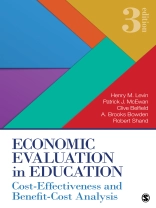The past decade has seen increased attention to cost-effectiveness and benefit-cost analysis in education as administrators are being asked to accomplish more with the same or even fewer resources, philanthropists are keen to calculate their ‘return on investment’ in social programs, and the general public is increasingly scrutinizing how resources are allocated to schools and colleges.
This text (titled Cost-Effectiveness Analysis in its previous editions) is the only full-length book to provide readers with the step-by-step methods they need to plan and implement a benefit-cost analysis in education. The authors examine a range of issues, including how to identify, measure, and distribute costs; how to measure effectiveness, utility, and benefits; and how to incorporate cost evaluations into the decision-making process. The updates to the Third Edition reflect the considerable methodological development in the evaluation literature, and the greater empiricism practiced by education researchers, to help readers learn to apply more advanced methods to their own analyses.
SAGE congratulates author Henry M. Levin, winner of the 2017 AERA Distinguished Contributions to Research in Education Award.विषयसूची
List of Tables, Figures, and Examples
Preface
Acknowledgments to the Second Edition
Acknowledgments to the Third Edition
About the Authors
Chapter 1. Introduction to Economic Evaluation
1.1. Purpose and Goals of the Book
1.2. The Importance of Economic Evaluations
1.3. Economic Evaluation for Decisionmaking in Education
1.4. Summary of Approaches to Economic Evaluation
1.5. Economic Evaluations and Policymaking
1.6. Outline of the Book
Discussion Questions
Chapter 2. Establishing an Analytic Framework
2.1. Identifying the Problem
2.2. Taking Account of the Audience and Perspective
2.3. Relating Economic Evaluation to the Theory of Change
2.4. Determining If Economic Evaluation Is Necessary
2.5. Conclusions
Discussion Questions
Exercises
Chapter 3. Cost Concepts
3.1. The Concept of Costs
3.2. Cost per Unit
3.3. Costs and the Theory of Change
3.4. Costs Data and Budgetary Information
3.5. Motivation for Cost Analysis
3.6. Conclusions
Discussion Questions
Exercises
Chapter 4. The Ingredients Method
4.1. Identifying Ingredients
4.2. Specifying Ingredients
4.3. Sources of Ingredients Information
4.4. Conclusions
Discussion Questions
Exercises
Chapter 5. Placing Values on Ingredients
5.1. Methods for Valuing Ingredients
5.2. Placing Dollar Values on Ingredients
5.3. Costs Over Multiple Years
5.4. Conclusions
Discussion Questions
Exercises
Chapter 6. Analyzing and Reporting Costs
6.1. Tabulating Total Cost Using a Cost Worksheet
6.2. Reporting Costs
6.3. Allocating Costs Among Constituencies
6.4. Analyzing Cost Determinants and Generalizing Costs
6.5. Conclusions
Discussion Questions
Exercises
Chapter 7. Effectiveness
7.1. Specifying Effectiveness
7.2. Methods for Identifying Effectiveness
7.3. Utility Analysis
7.4. Conclusions
Discussion Questions
Exercises
Chapter 8. Cost-Effectiveness Analysis
8.1. Cost-Effectiveness Ratios
8.2. Alternative Cost-Effectiveness Metrics
8.3. Interpreting Cost-Effectiveness Ratios
8.4. Explaining Cost-Effectiveness Ratios
8.5. Evidence on Cost-Effective Interventions
8.6. Conclusions
Discussion Questions
Exercises
Chapter 9. Estimating Benefits
9.1. The Concept of Benefits
9.2. Specifying Benefits
9.3. Valuing Educational Benefits Through Earnings
9.4. Valuing Educational Benefits Through Shadow Pricing
9.5. Applying Benefits in Benefit-Cost Analysis
9.6. Conclusions
Discussion Questions
Exercises
Chapter 10. Benefit-Cost Analysis
10.1. Combining Benefits and Costs Into Economic Metrics
10.2. Performing Benefit-Cost Analysis
10.3. Examples of Benefit-Cost Analysis
10.4. Conclusions
Discussion Questions
Exercises
Chapter 11. Accounting for Uncertainty
11.1. Type of Uncertainty and Sensitivity
11.2. General Sensitivity Testing
11.3. Sensitivity Testing of Cost Estimates
11.4. Sensitivity Testing of Cost-Effectiveness
11.5. Sensitivity Testing of Benefit-Cost Analysis
11.6. Distributional Issues
11.7. Conclusions
Discussion Questions
Exercises
Chapter 12. Checklist for Economic Evaluations
12.1. A Checklist for Appraising Economic Evaluations
12.2. Appraising Economic Evaluations
12.3. Conclusions
Discussion Questions
Exercises
Chapter 13. Economic Evaluations for Education Policy
13.1. Applying Economic Analysis
13.2. Expanding the Use of Economic Evaluation
13.3. Decisionmaking and Economic Evaluation
13.4. Prioritizing Educational Investments
13.5. Using Economic Evaluations to Improve Education Research
13.6. The Future of Economic Evaluation of Education
13.7. A Final Word
Discussion Questions
Appendix A. Answers to Even-Numbered Exercises
Appendix B. Cost Out Tool
References
Index
लेखक के बारे में
Robert D. Shand is the Novice G. Fawcett postdoctoral researcher in educational studies at The Ohio State University. He completed his Ph.D. in Economics and Education at Teachers College, Columbia University. As a former K-12 teacher, his research focuses on how educational practitioners use evidence on effectiveness and costs to improve decision-making and how teachers improve over time through formal training and learning from colleagues.












